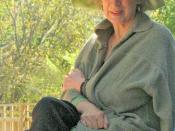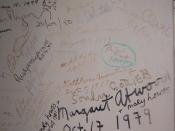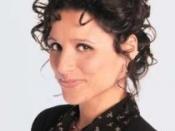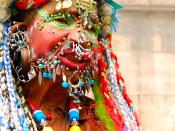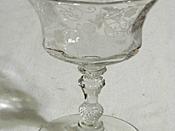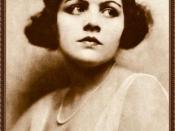"Our commonsense explanations of the world and ourselves are problematised by Atwood through her novel. Nothing is quite as it seems, when we look at anything (in a mirror, in the past, at others) it is refracted as if through water." Discuss the ideas and issues in the novel in relation to this statement, paying particular attention to the techniques and narrative elements used to show this.
Our commonsense explanations of the world are based on the absolutes in our lives. Ways of seeing have been socially constructed embedded with values and attitudes that influence our behaviour and view of the world and ourselves. Reality cannot be captured and is interpreted differently by every individual as if refracted through water. Cat's Eye is a work of influential English by author Margaret Atwood. The novel's central area of exploration is of different versions of reality, and the accuracy and truthfulness of our own visions of how we see the world and ourselves.
These visions are problematised by Atwood, as she uses various techniques that allow her to discretely proffer her idea of 'nothing is quite as it seems' to position the audience. This results in our own endorsement of these beliefs, and leads us to question our own lives as just a version of reality, with a sense of disillusionment. Our world and our own lives are challenged by Atwood's novel, as in questioning the idea of no absolutes and constants in our lives, we also begin to question the other constants in our society such as religion being just another version of reality and not an absolute. This distresses many people and problematises our lives. Measurable, knowable, constant, and absolute qualities of life provide security in our beliefs and understanding of the world and our place within it. Absolutes help us make sense of the world, and provide a connection to the world and our own inner selves generating a sense of belonging. Atwood challenges the concept of absolutes, fixed/knowable identities, and common truths through various techniques. She uses narrative elements to proffer her ideas, such as autobiographical writing to encourage us to question the one and only version of reality that is being told (through Elaine and her life). Imagery/symbolism and intertextuality are recurring techniques, for example her repetitive use reflective surfaces such a glass, water and mirrors are all symbols used to question reflection, and how we see ourselves; is what we see what we get? These techniques are used in order to provoke self-doubt and insecurity, to unsettle and complicate the way we see ourselves and our world, through the provocative questions that it asks of us. Cat's eye challenges the naturalized and socially constructed views and encourages the reader to question the dominant views of the world and themselves.
Refraction is the distortment of light, as it travels, it's broken-up as it changes and moves through different mediums. Atwood uses refraction as a symbol representing the key belief that our vision of life and ourselves is refracted, broken up, distorted, and that as a result our perceptions aren't always accurate. Atwood uses Elaine's second encounter at the bridge to imply that our views, especially on other people are refracted, and not necessarily as they seem to be. Cordelia is seen to effect Elaine the most significantly, and it is not until the end of the book, when Elaine is finally coming back to herself (the bridge) that Elaine realises that Cordelia was not what she seemed to be.
"There is the same shame, the sick feeling in my body, the same knowledge of my own wrongness, awkwardness, weakness; the same wish to be loved; the same loneliness; the same fear. But these are not my own emotions anymore. They are Cordelia's; as they always were."It is only at the end of Elaine's life when she realizes that her emotions that traumatized her childhood (and adult life) were in fact Cordelia's, who in order to escape them and cope transferred them to Elaine. Elaine feels stronger with this knowledge and finally releases Cordelia, as the Virgin Mary once released her "Its ok, you can go home now." Elaine's mourning is over and she is free of Cordelia, she can see clearly now- "The snow in my eyes withdraws like smoke" and is starting to make sense of her past. Atwood also uses Elaine's misconception of Cordelia to exemplify how our 'refracted' view of others substantially affects our view of ourselves and the world; our experience of the present is coloured by our past events. Elaine realises that all these years, she still did not 'know' Cordelia, supporting Atwood's dispute of the notion that there can really be a 'fixed' and 'knowable' identity. Atwood employs this metaphor in order to position the reader to be receptive to the idea that our views on others, the world, and ourselves are not absolute but equivocal.
In Cat's Eye the first person limited narration is unreliable in the sense that Elaine cannot 'see' enough - either because of her own maturation and desires and the forces conditioning them, or of the consequences of her choices. The novel questions whether 'lives', 'stories' or autobiographical narratives can ever be accurate. A novel that presents a straightforward linear narrative that moves through events sequentially and constructs a complete set of ideas about life that seem unproblematic. It accepts that our experience of life, our thoughts and feeling, motivations, movement through time - our very representation in a literary text, can be captured accurately. It implies order, coherence, unity and stability; a rational basis for our actions and thoughts thus presenting a conservative worldview. The structure of Cat's Eye serves as a critique of this unproblematic view of the world. The novel constantly shifts between past and present and her narration as a young Elaine and an old Elaine. This shifting represents Elaine's life, as she feels it is barley comprehensible. Because the story is written in first person, its only presents one version of reality- Elaine's version. This leads us to question Elaine's version and its accuracy. Atwood's purpose behind this is to bring to light the complexity of character in Elaine, and highlight her struggle in coming to terms with her own identity. This challenge on the common qualities of autobiographical narratives even leads the reader to question Cat's Eye as just another version of reality that is presented to us in life.
Atwood questions the belief that the individual is knowable and that appearance corresponds with fixed reality; she critiques the notion that reality can be 'captured'. This is shown through her questioning of autobiographical writing, and is perpetuated through the use of Elaine's paintings at her gallery Sub-versions. Cordelia subjected Elaine to subtle, psychological bullying as a child, and destroyed her self-confidence, which lasts well into her adult life. Her art is a way of expressing these bottled-up emotions and a means of dealing with her trauma; her art presents a different version of reality of her life, one that she is unable to confront in her everyday life. "I can no longer control these paintings, or tell them what to mean. Whatever energy they have came out of me. I'm what's left over."Through her art she exerts a power that she did have in her childhood, taking revenge on Mrs. Smeath and confronting other issues such as her bullying in the painting Cat's Eye, where Elaine appropriates the idea of the pier glass reflecting figures outside the frames of the main picture. This glass hangs behind a self-portrait that shows only half of Elaine's head and incorporates signs of aging. In her childhood the three girls watch her from behind yet the young Elaine in the picture is turned around, facing her tormentors. The painting symbolises the claiming and relinquishing of control. The child, Elaine looks back at the three girls, the adult Elaine looks back at the outside viewer. The back of the head is crucial: a mirror that shows only the ruined half of your face. Elaine's art reflects the psychological state she is in and has faced in her childhood. This is symbolic of Elaine looking back on her life and seeing her childhood in a different light-'Nothing is what it really seems.' The gallery is appropriately named, contributing to Atwood's hypothesis; Life is a series of different and conflicting versions of reality, identity and reality are not fixed and the concept of 'exact truth' can never be captured.
Atwood's novel Cat's Eye shapes the reality by which we view the world and ourselves. Our lives operate around security (especially of ourselves) and we generate and understanding and connect ourselves to the world through various versions of reality that we reinforce to become believed 'absolutes' upon which we base our lives Without the 'fixed reality' we create for ourselves and the absolutes that structure our lives, our sense of purpose, and meaning diminishes. Distress is brought upon us through Cat's Eye because Atwood critiques our quest for identity as she suggests that we will never 'know ourselves' and will never have a fixed identity. It is therefore the reader's choice on weather to comprehend the notions Atwood is proffering. Atwood uses varied techniques and narrative elements such as imagery, symbolism, and the narrative point of view to allude her beliefs. Through the particular employment of these techniques Atwood strengthens her case to the reader and positions them to support her indited criticisms of a knowable identity, and a fixed reality and truth. Cats Eye challenges the measurable, and the way we qualify things as knowable and existing and a truth.
Bibliography:Atwood, Margaret, Cat's Eye, Penguin, Montreal 1968
